Sarah L. Johnson's Blog, page 9
July 22, 2024
Michelle Moran's Maria looks for the real story behind The Sound of Music's complicated heroine
 Michelle Moran’s gripping new novel Maria (whose subject, Maria von Trapp, will be recognizable from the beautiful cover) left me pondering the reasons why people choose to tell the stories they do. In 1959, as Arthur Hammerstein is finalizing the lyrics for a Broadway musical about her life, Maria writes him a letter requesting a meeting. She doesn’t like the way her family is being depicted in the play, especially how her late husband, Georg, is shown as a strict disciplinarian.
Michelle Moran’s gripping new novel Maria (whose subject, Maria von Trapp, will be recognizable from the beautiful cover) left me pondering the reasons why people choose to tell the stories they do. In 1959, as Arthur Hammerstein is finalizing the lyrics for a Broadway musical about her life, Maria writes him a letter requesting a meeting. She doesn’t like the way her family is being depicted in the play, especially how her late husband, Georg, is shown as a strict disciplinarian. Hammerstein sends his assistant, Fran Connelly (a fictional character), to meet with Maria and hopefully assuage her concerns, plus prevent any potential bad press. Maria’s tale then unfolds in the first person, beginning when she, as a postulant at Nonnberg Abbey, was sent to tutor one of the daughters of Baron Georg von Trapp, a war hero and widower. Maria re-introduces his seven children to music and the simple joys of playtime. This aspect doesn’t diverge far from the play and film, but later parts of Maria’s life are a different story.
The Christmas holidays in the von Trapp household are recreated in such idyllic scenes that even the nonreligious will be tempted to book a trip to Salzburg next winter! But the real Maria was a complicated woman, shown here with considerable complexity, who endured physical abuse by a relative as a child. While her ambitions for the family’s singing careers may have saved them, her domineering behavior caused mental anguish for her own children.
Readers will grasp the amusing irony that this is a novel about a woman who resisted being fictionalized. Yet Maria succeeds in presenting a well-rounded, nuanced portrait that draws its information from multiple sources, since no one account (not even Maria’s autobiographies) presents a complete image of her character. It’s a must-read for anyone who loves biographical fiction, and it provides understanding about why The Sound of Music took the fictional liberties that it did.
Maria will be published by Dell on July 30th. Thanks to the publisher for providing me with a copy.
Published on July 22, 2024 10:46
July 14, 2024
Libbie Hawker's Mercer Girls brings three determined women to frontier Seattle
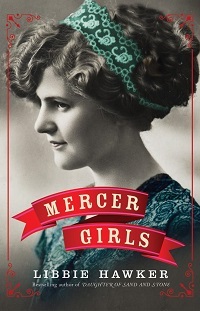 Libbie Hawker’s Mercer Girls takes its name from a group of enterprising young women from around Lowell, Massachusetts, who were recruited by Asa Mercer in the 1860s to travel to Washington Territory, which suffered from a major gender imbalance. They journeyed via ship from New York via Panama and up the Pacific coast to Seattle, debarking at a grimy, half-built frontier town where they – educated women of respectable backgrounds – found their reputations challenged by a society who believed only females with low morals would leave their homes behind as they did.
Libbie Hawker’s Mercer Girls takes its name from a group of enterprising young women from around Lowell, Massachusetts, who were recruited by Asa Mercer in the 1860s to travel to Washington Territory, which suffered from a major gender imbalance. They journeyed via ship from New York via Panama and up the Pacific coast to Seattle, debarking at a grimy, half-built frontier town where they – educated women of respectable backgrounds – found their reputations challenged by a society who believed only females with low morals would leave their homes behind as they did. Hawker smoothly shifts the viewpoints among three main characters, each of whom has different reasons for wanting a fresh start: thirtyish Josephine, fleeing a secret past; impoverished mill owner’s daughter Dovey, whose combined naivete and uncontrollable ambitions prove dangerous; and prim Sophronia, whose Christian uprightness is off-putting. Each is uniquely sympathetic yet flawed, and their personalities realistically transform over time.
This isn’t a standard heartwarming story of female cooperation during adversity, since Jo, Dovey, and Sophronia frequently clash (especially the latter two). Despite expectations they find husbands asap, the women forge their own paths. The historical background will attract fans of Western heroines and, especially, those who enjoyed Robin Oliveira’s recent A Wild and Heavenly Place, set amid the gorgeous but rough landscape of Washington Territory a bit later.
The plot unfolds with details on the early suffrage fight (this bogs down the story at the end), prostitution (seen as a lucrative career choice), and the process of tax collection (more interesting than it sounds). Overall, it’s a fast-moving portrait of the scrappiness needed for survival on the frontier, and how three “Mercer girls” found it within themselves.
I read Mercer Girls (Lake Union, 2016) from a NetGalley copy I'd left unread for too long. Read more about the original "Mercer girls" via the New England Historical Society.
Published on July 14, 2024 07:24
July 10, 2024
Tropical glamour and gothic suspense in Chanel Cleeton's The House on Biscayne Bay
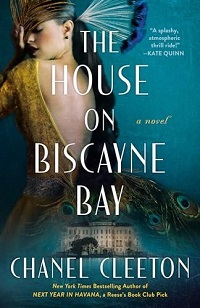 Cleeton’s dual-period mystery intermixes tropical heat and gothic chills in a satisfying way as two women, decades apart, face up to shocking truths. The glamour factor is high as Anna Barnes and Carmen Acosta each arrive at Marbrisa, a palatial Miami showpiece, but despite its ornate furnishings and beautifully manicured grounds, neither finds their new home comfortable at all.
Cleeton’s dual-period mystery intermixes tropical heat and gothic chills in a satisfying way as two women, decades apart, face up to shocking truths. The glamour factor is high as Anna Barnes and Carmen Acosta each arrive at Marbrisa, a palatial Miami showpiece, but despite its ornate furnishings and beautifully manicured grounds, neither finds their new home comfortable at all.Just after the Great War, Anna’s longtime husband, Robert, a wealthy businessman, whisks her from New York to Florida and presents her with Marbrisa as a birthday gift. Anna is a shy woman with subdued tastes; the architect notes her dismay and tries adapting it to her preferences, but just when she’s getting accustomed to her new residence, a young woman attending the Barneses’ glitzy evening gala is discovered drowned.
In 1941, eighteen-year-old Carmen moves from Cuba after her parents’ deaths to live with her older sister Carolina and brother-in-law Asher Wyatt, Marbrisa’s new owners. Carolina, to whom Carmen was never close, seems unnaturally guarded and may be having an affair. With nowhere else to go, and Asher overseeing her inheritance, Carmen doesn’t know who to trust.
How well do we really know the people we love? This important question guides the novel’s suspense. To Anna, Robert has always been a devoted partner, but does he have secrets? Who is causing disturbances at Marbrisa in the ´40s, and how do they relate to the reasons why the house was abandoned and believed cursed?
The action moves fast, and Cleeton proves a daring writer as the plot twists unexpectedly. Alongside deadly alligators, shrieking peacocks, and fierce winds whipping off the bay, the uneasy atmosphere suits the historical backdrop, with rich northerners swooping in on undeveloped Florida land, and locals eyeing the rich interlopers with curious envy and resentment. The ending is perfect, too.
The House on Biscayne Bay was published in April by Berkley. This is the 2nd novel by Cleeton that I've read, the first being The Most Beautiful Girl in Cuba .
Published on July 10, 2024 06:32
July 3, 2024
New reader survey emphasizing historical fiction: invitation to participate
Please excuse the recent delay with new posts, as I've been out of town.
M.K. (Mary) Tod, a friend from the historical fiction community who writes in the genre and compiles the A Writer of History blog, has come out with a 5th survey taking a look at reading habits and preferences. This year's survey asks questions about book formats, social media interactions, and how you as a reader find out about books. There's a special focus on historical fiction, so you'll get to weigh in on your time period preferences, what genres you enjoy most, and more.
Take the survey here: https://www.surveymonkey.com/r/LSYVTG7
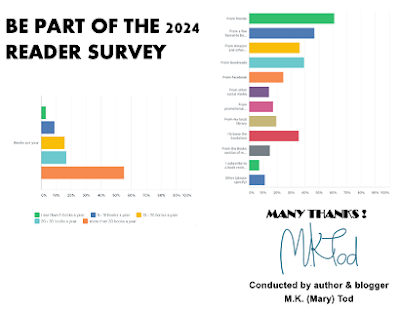
The survey is likely to remain open through late July. For the results of earlier surveys (2012 through 2018), see A Writer of History.
M.K. (Mary) Tod, a friend from the historical fiction community who writes in the genre and compiles the A Writer of History blog, has come out with a 5th survey taking a look at reading habits and preferences. This year's survey asks questions about book formats, social media interactions, and how you as a reader find out about books. There's a special focus on historical fiction, so you'll get to weigh in on your time period preferences, what genres you enjoy most, and more.
Take the survey here: https://www.surveymonkey.com/r/LSYVTG7

The survey is likely to remain open through late July. For the results of earlier surveys (2012 through 2018), see A Writer of History.
Published on July 03, 2024 10:46
June 23, 2024
The first volume of Conn Iggulden's Nero trilogy dramatizes the survival instinct and bold ambition of his mother, Agrippina
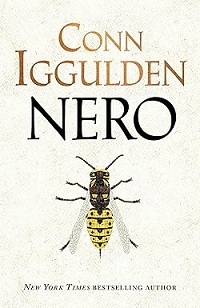 After an excursion to ancient Greece, most recently in Empire (2023), Iggulden circles back to Rome, the setting for his original Emperor series, as he begins a new trilogy about the forces that shaped Emperor Nero’s life.
After an excursion to ancient Greece, most recently in Empire (2023), Iggulden circles back to Rome, the setting for his original Emperor series, as he begins a new trilogy about the forces that shaped Emperor Nero’s life. Nero is still a child when this novel wraps up with the Roman invasion of Britain in 43 CE, so his mother, Empress Agrippina, is the focal point here. Using her considerable wiles and attractiveness, Agrippina conceives a plan for maneuvering her son into the position of imperial heir and does whatever it takes to succeed.
Spanning the paranoid finale of Tiberius’ reign through Caligula’s madness and the accession of the scholarly Claudius, ruthless in his own way, the story illustrates the era’s political infighting, depravity, and bloody viciousness using full-color imagery and eloquent language that sings with vigor. “Life was violence,” Agrippina comes to believe, “If you survived, you walked away to heal and plot your revenge.” Honor exists, but is rarely rewarded.
Iggulden acknowledges taking some historical liberties to streamline his tale, which zips along with great energy.
Nero was published by Pegasus in the US last month, and I wrote this review for Booklist's historical fiction issue, which came out on May 15. Michael Joseph is the UK publisher for Nero, and that edition has a very similar cover. This is the third of Iggulden's novels I've reviewed for Booklist, the others being The Gates of Athens and Protector, set in ancient Greece, both of which I enjoyed thoroughly.
Nero is actually called Lucius in this book; his name at birth was Lucius Domitius Ahenobarbus. He received his new name following adoption by his stepfather (and great-uncle) Claudius some years later. It will be interesting to compare this new series with Margaret George's duology about Nero as it continues: those books are The Confessions of Young Nero and The Splendor Before the Dark .
Published on June 23, 2024 08:10
June 15, 2024
All We Were Promised portrays three Black women's friendship and hopes for freedom in 1830s Philadelphia
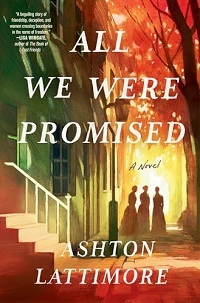 Lattimore’s debut exudes originality in its characters, plot situations, and especially in its well-chosen setting of 1830s Philadelphia, “the self-proclaimed cradle of liberty,” a landmark American city whose grand ideals of freedom and brotherly love fall short for its Black residents. The opening scene makes plain this philosophical struggle. As Charlotte Walker and Nell Gardner attend a speech by prominent abolitionist Robert Purvis in Washington Square Park, white men’s resentment agitates a violent mob.
Lattimore’s debut exudes originality in its characters, plot situations, and especially in its well-chosen setting of 1830s Philadelphia, “the self-proclaimed cradle of liberty,” a landmark American city whose grand ideals of freedom and brotherly love fall short for its Black residents. The opening scene makes plain this philosophical struggle. As Charlotte Walker and Nell Gardner attend a speech by prominent abolitionist Robert Purvis in Washington Square Park, white men’s resentment agitates a violent mob.The young women’s worlds rarely intersect; their friendship is an exception. Nell’s family are well-to-do Black elites who have been free for generations, while Charlotte had escaped a Maryland plantation with her father four years earlier, a fact she keeps hidden. Charlotte is forced to serve as housemaid to her ambitious father while he passes for white and establishes an upscale woodworking business.
Charlotte gradually opens Nell’s eyes to the hypocritical limitations of the Philadelphia Female Antislavery Society that Nell belongs to, since it hesitates to take action to help runaway slaves, even as these needs become immediate. Charlotte had left her younger friend Evie behind when she fled Maryland, and when Evie arrives in Philadelphia with her enslaver, the self-absorbed Missus Kate, Charlotte risks having her cover blown.
The viewpoint nimbly switches among the three lead characters, and pre-Civil War Philadelphia arises fully formed on the page with its diverse residential neighborhoods, public spaces, and a moral edifice whose structure is continually tested. The storyline keeps readers guessing on how everyone’s relationships will evolve under the weight of secrets: not just the women’s friendships, but also Nell’s potential romance with a family friend and Charlotte’s strained bond with her father/boss, who refuses to acknowledge their past. A few too-modern word choices stand out (“slow-walked”), but this is an altogether absorbing, thought-provoking story.
Ashton Lattimore's All We Were Promised was published by Ballantine in April; I reviewed it initially for May's Historical Novels Review.
Published on June 15, 2024 11:58
June 11, 2024
These 24 novels showcase the popularity, diversity, and vibrancy of today's Gothic historical fiction
Gothic historical fiction has exploded in popularity, a trend I couldn’t be happier about. I’ve been reading gothic novels since grade school, with favorites including Mary Stewart, Victoria Holt, Katheryn Kimbrough, and Barbara Michaels. In the standard plotline, a sheltered young woman arrives at a mansion in a remote corner of England, often to work as a governess, and finds herself engulfed in secrets and danger, ones revolving around the forbiddingly handsome master of the house.
In the 1970s and '80s, "gothic” was often synonymous with “romantic suspense,” but while the secretive atmosphere and mystery subplots remain, today’s gothics may or may not have happily-ever-after endings. What you’re more likely to find, along with a strong message of feminine agency, are women who find the strength to save themselves. In terms of characters and settings, the offerings today are considerably more diverse than those of yesteryear. To add unpredictability and additional suspense, their writers switch up the standard gothic tropes in intriguing ways. Key titles in this subgenre include Silvia Moreno-Garcia’s Mexican Gothic, Kate Morton’s sagas, Sarah Waters’ Fingersmith, and Sarah Penner’s feminist gothic mysteries.
Below are two dozen gothic historicals appearing in 2024. I started out with a list of twelve and kept finding more, and I’m sure there are plenty I’ve left out. Which ones will be added to your wishlist?
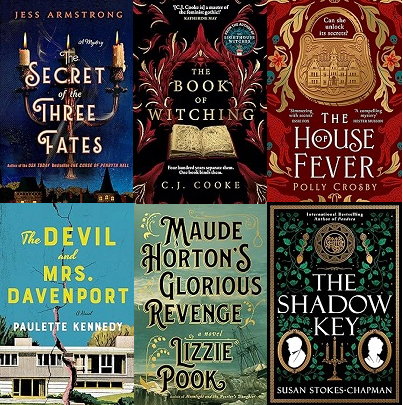
Jess Armstrong’s The Secret of the Three Fates (Minotaur, Dec.) introduces American Ruby Vaughn, in her second fiction outing, to seances along the Scottish border after WWI. The Book of Witching by C. J. Cooke (HarperCollins UK, Oct.) offers another original Gothic setting in its tale of two imperiled women in the present day and the 16th-century Orkney Islands. Moving ahead to the 1930s, Polly Crosby’s gothic mystery The House of Fever (HQ, Aug.) is set in a tuberculosis sanitorium. Pandora author Susan Stokes-Chapman’s second novel The Shadow Key (Harper Perennial, Sept; also Harvill Secker, Apr.) features a male protagonist, a physician encountering secrets on a remote estate in rural 18th-century Wales. Lizzie Pook’s Maude Horton’s Glorious Revenge (Picador, Feb.) has a woman investigating her sister’s Arctic disappearance in Victorian London, while religious repression and sexism intermingle in Paulette Kennedy’s The Devil and Mrs. Davenport (Lake Union, Mar.), with a housewife in 1950s Missouri unexpectedly receiving messages from beyond the grave.
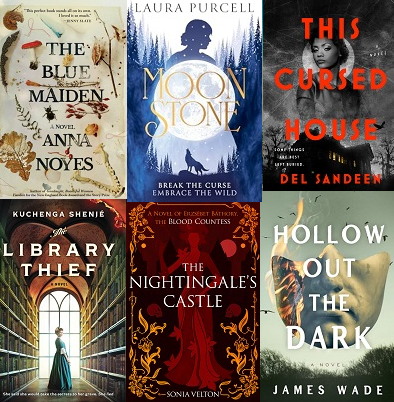
The title of Anna Noyes’ The Blue Maiden (Grove, Apr.) refers to an uninhabited Scandinavian island, one reputed to be the site of devil worshippers; a family on a neighboring island in the 19th century, descended from an accused witch, remains haunted by its legacy. Laura Purcell’s name should be familiar to fans of gothics; Moonstone (Magpie, May), her first YA, is a supernatural romance with LGBTQ rep set in the early 19th century. Del Sandeen’s fiction debut This Cursed House (Berkley, Oct), described as Southern gothic horror, has a Black woman from 1960s Chicago relocating to New Orleans to work for a family that’s been cursed. Kuchenga Shenjé’s The Library Thief (Hanover Square, May; also Sphere, Apr.) another debut, follows a Jamaican-born young woman in Victorian England who uncovers secrets in an estate’s private collection of rare books. Heading back to 16th-century Hungary, Sonia Velton’s The Nightingale’s Castle (Harper Perennial, July; also Abacus, May), looks into the notorious legend of “Blood Countess” Erzsébet Báthory. James Wade’s Hollow Out the Dark (Blackstone, Aug.), described as gothic adventure set in Depression-era Texas, has a WWI vet diving into dangerous situations and secrets.
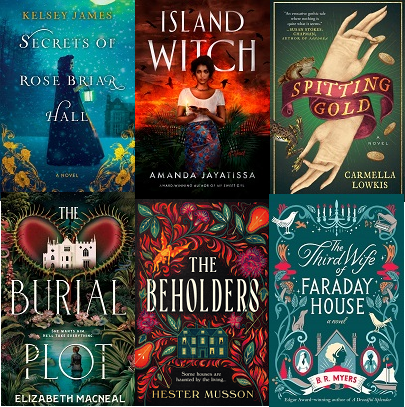
Traditional gothic plots are infused with unique twists in all of these novels. In Kelsey James’ Secrets of Rose Briar Hall (Kensington, June), set in Gilded Age New York, a wealthy young wife awakens to a mystery and amnesia the night after a large society party. Nineteenth-century Sri Lanka (formerly Ceylon) follows Amara, a demon-priest’s daughter, as she tries to clear her father’s name in the dark supernatural tale Island Witch by Amanda Jayatissa (Berkley, Feb.). In 1860s Paris, two estranged sisters stage a haunting to scam a secretive family and pay their bills, but their attempted fraud backfires in Carmella Lowkis’s Spitting Gold (Atria, May). Elizabeth Macneal’s The Burial Plot (Picador UK, June), set in early Victorian England, also focuses on a pair of fraudsters, one of whom flees a risky situation by posing as a lady’s maid in a house full of secrets. Hester Musson’s The Beholders (Fourth Estate, Jan.), her debut, involves a maid in Victorian England who unearths secrets about the mysterious household residents. In Regency-era Nova Scotia, Emeline, the protagonist in B. R. Myers’ The Third Wife of Faraday House (William Morrow, Aug.), discovers a surprise when she arrives at her prospective husband’s seaside manor: her predecessor is still alive.

Some more terrific settings in this batch! House of Shades by Lianne Dillsworth (Harper, July; also Hutchinson Heinemann, May) has the title character, a Black woman doctor, on a risky mission in 1830s London that threatens to reveal long-held mysteries. Chanel Cleeton takes a gothic turn in her latest, The House on Biscayne Bay (Berkley, Apr.), following two women decades apart who live at a glamorous mansion in south Florida. Donyae Coles’ debut, Midnight Rooms (Amistad, July), sees orphaned mixed-race heroine Orabella marrying a wealthy man she barely knows in 1840 England. The Silence Factory by Bridget Collins (William Morrow, Aug.; also The Borough Press, May), best known for The Binding, is multi-period suspense about surprising discoveries made on a Greek island in the 1820s. Secrets and spirits from the Russian Revolution percolate into the 1920s in Olesya Salnikova Gilmore’s second novel, The Haunting of Moscow House (Berkley, Sept.), while Barbara Havelocke’s Estella’s Revenge (Canelo Hera, May) retells Great Expectations from the viewpoint of Miss Havisham’s daughter.
In the 1970s and '80s, "gothic” was often synonymous with “romantic suspense,” but while the secretive atmosphere and mystery subplots remain, today’s gothics may or may not have happily-ever-after endings. What you’re more likely to find, along with a strong message of feminine agency, are women who find the strength to save themselves. In terms of characters and settings, the offerings today are considerably more diverse than those of yesteryear. To add unpredictability and additional suspense, their writers switch up the standard gothic tropes in intriguing ways. Key titles in this subgenre include Silvia Moreno-Garcia’s Mexican Gothic, Kate Morton’s sagas, Sarah Waters’ Fingersmith, and Sarah Penner’s feminist gothic mysteries.
Below are two dozen gothic historicals appearing in 2024. I started out with a list of twelve and kept finding more, and I’m sure there are plenty I’ve left out. Which ones will be added to your wishlist?

Jess Armstrong’s The Secret of the Three Fates (Minotaur, Dec.) introduces American Ruby Vaughn, in her second fiction outing, to seances along the Scottish border after WWI. The Book of Witching by C. J. Cooke (HarperCollins UK, Oct.) offers another original Gothic setting in its tale of two imperiled women in the present day and the 16th-century Orkney Islands. Moving ahead to the 1930s, Polly Crosby’s gothic mystery The House of Fever (HQ, Aug.) is set in a tuberculosis sanitorium. Pandora author Susan Stokes-Chapman’s second novel The Shadow Key (Harper Perennial, Sept; also Harvill Secker, Apr.) features a male protagonist, a physician encountering secrets on a remote estate in rural 18th-century Wales. Lizzie Pook’s Maude Horton’s Glorious Revenge (Picador, Feb.) has a woman investigating her sister’s Arctic disappearance in Victorian London, while religious repression and sexism intermingle in Paulette Kennedy’s The Devil and Mrs. Davenport (Lake Union, Mar.), with a housewife in 1950s Missouri unexpectedly receiving messages from beyond the grave.

The title of Anna Noyes’ The Blue Maiden (Grove, Apr.) refers to an uninhabited Scandinavian island, one reputed to be the site of devil worshippers; a family on a neighboring island in the 19th century, descended from an accused witch, remains haunted by its legacy. Laura Purcell’s name should be familiar to fans of gothics; Moonstone (Magpie, May), her first YA, is a supernatural romance with LGBTQ rep set in the early 19th century. Del Sandeen’s fiction debut This Cursed House (Berkley, Oct), described as Southern gothic horror, has a Black woman from 1960s Chicago relocating to New Orleans to work for a family that’s been cursed. Kuchenga Shenjé’s The Library Thief (Hanover Square, May; also Sphere, Apr.) another debut, follows a Jamaican-born young woman in Victorian England who uncovers secrets in an estate’s private collection of rare books. Heading back to 16th-century Hungary, Sonia Velton’s The Nightingale’s Castle (Harper Perennial, July; also Abacus, May), looks into the notorious legend of “Blood Countess” Erzsébet Báthory. James Wade’s Hollow Out the Dark (Blackstone, Aug.), described as gothic adventure set in Depression-era Texas, has a WWI vet diving into dangerous situations and secrets.

Traditional gothic plots are infused with unique twists in all of these novels. In Kelsey James’ Secrets of Rose Briar Hall (Kensington, June), set in Gilded Age New York, a wealthy young wife awakens to a mystery and amnesia the night after a large society party. Nineteenth-century Sri Lanka (formerly Ceylon) follows Amara, a demon-priest’s daughter, as she tries to clear her father’s name in the dark supernatural tale Island Witch by Amanda Jayatissa (Berkley, Feb.). In 1860s Paris, two estranged sisters stage a haunting to scam a secretive family and pay their bills, but their attempted fraud backfires in Carmella Lowkis’s Spitting Gold (Atria, May). Elizabeth Macneal’s The Burial Plot (Picador UK, June), set in early Victorian England, also focuses on a pair of fraudsters, one of whom flees a risky situation by posing as a lady’s maid in a house full of secrets. Hester Musson’s The Beholders (Fourth Estate, Jan.), her debut, involves a maid in Victorian England who unearths secrets about the mysterious household residents. In Regency-era Nova Scotia, Emeline, the protagonist in B. R. Myers’ The Third Wife of Faraday House (William Morrow, Aug.), discovers a surprise when she arrives at her prospective husband’s seaside manor: her predecessor is still alive.

Some more terrific settings in this batch! House of Shades by Lianne Dillsworth (Harper, July; also Hutchinson Heinemann, May) has the title character, a Black woman doctor, on a risky mission in 1830s London that threatens to reveal long-held mysteries. Chanel Cleeton takes a gothic turn in her latest, The House on Biscayne Bay (Berkley, Apr.), following two women decades apart who live at a glamorous mansion in south Florida. Donyae Coles’ debut, Midnight Rooms (Amistad, July), sees orphaned mixed-race heroine Orabella marrying a wealthy man she barely knows in 1840 England. The Silence Factory by Bridget Collins (William Morrow, Aug.; also The Borough Press, May), best known for The Binding, is multi-period suspense about surprising discoveries made on a Greek island in the 1820s. Secrets and spirits from the Russian Revolution percolate into the 1920s in Olesya Salnikova Gilmore’s second novel, The Haunting of Moscow House (Berkley, Sept.), while Barbara Havelocke’s Estella’s Revenge (Canelo Hera, May) retells Great Expectations from the viewpoint of Miss Havisham’s daughter.
Published on June 11, 2024 05:00
June 6, 2024
Secrets abound in 1920s London in Marty Wingate's newest cozy mystery
 Kudos to Marty Wingate for writing an engaging cozy mystery whose solution is a clever and unpredictable puzzle. A Body at the Dance Hall is third in a series featuring the perky, adventurous Miss Mabel Canning, who takes assignments with the Useful Women agency in 1922 London – private investigation is her specialty – while quietly investigating murders.
Kudos to Marty Wingate for writing an engaging cozy mystery whose solution is a clever and unpredictable puzzle. A Body at the Dance Hall is third in a series featuring the perky, adventurous Miss Mabel Canning, who takes assignments with the Useful Women agency in 1922 London – private investigation is her specialty – while quietly investigating murders. When Mabel gets approached about a posh gig as companion to a wealthy young American woman newly arrived in London, she looks forward to livening up her dull January by showing her charge around town. But Roxanne Arkwright, eighteen-year-old daughter of a British industrialist and his Chicago-based first wife, appears to be a high-maintenance handful.
Then, on the pair’s evening out at the Hammersmith Palais de Danse, Mabel garbed in slinky knee-length blue chiffon velvet, our sleuth gets locked in the hall’s larder by a fellow detective hired by the Arkwrights to watch Roxanne. An hour later, after Mabel is freed by an old contact at Scotland Yard, she finds the young man lying dead, and Roxanne frantic with worry about her.
The mystery plot gets deliciously complicated as it changes from having no real suspects at all, since the motive for the crime isn’t clear, to nearly everyone being a suspect. Secrets are afoot! Wingate scatters red herrings hither and thither until the perpetrator comes into surprising focus, and the book’s revelations don’t end there.
This volume stands alone perfectly, with only light allusions to Mabel’s two previous outings. The fashions and hairstyles are fabulous, the historical atmosphere lively, and the characters a fun mix, including Gladys, the friendly terrier owned by Mabel’s beau, Park Winstone. (Better naming consistency would be great; he’s called Park and Winstone equally frequently.) But let’s see more of Mabel and her fellow Useful Women, please.
A Body at the Dance Hall was published by Bookouture in April, and I'd reviewed it from NetGalley for May's Historical Novels Review. The two previous books are A Body on the Doorstep and A Body at the Séance, but you don't need to read them first. I wish more historical mystery authors would make the effort to have their books stand alone, since it makes it so much easier for new readers. And since there weren't any spoilers, I went back and got copies of the first two.
Published on June 06, 2024 04:30
May 30, 2024
The Passionate Tudor by Alison Weir depicts the complicated, ultimately tragic life of Queen Mary I
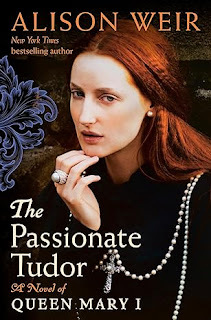 Mary I, England’s first true queen regnant, isn’t generally recognized for her admirable steadfastness, like her mother Catherine of Aragon, or her canny survival instinct, like her half-sister, Elizabeth I, although she exhibited both these qualities. Instead, due to her zealous persecution of Protestants, the sobriquet "Bloody Mary" clings to her. Her actions make her a challenging fiction subject, but Tudor expert Weir (The King’s Pleasure, 2023) dexterously humanizes this polarizing figure.
Mary I, England’s first true queen regnant, isn’t generally recognized for her admirable steadfastness, like her mother Catherine of Aragon, or her canny survival instinct, like her half-sister, Elizabeth I, although she exhibited both these qualities. Instead, due to her zealous persecution of Protestants, the sobriquet "Bloody Mary" clings to her. Her actions make her a challenging fiction subject, but Tudor expert Weir (The King’s Pleasure, 2023) dexterously humanizes this polarizing figure. Following a cosseted childhood as Henry VIII’s elder daughter, Mary gets sidelined during her father’s pursuit of Anne Boleyn and break with Rome. Mary’s health suffers during many stressful years, and Weir casts a sympathetic light on Mary as she endures demotion and disinheritance, relying on her supporters and Catholic faith. But following her triumphant coronation, her marriage to Philip of Spain and cruel religious intolerance make her extremely unpopular.
Weir aptly demonstrates how politics and personal relationships intermix via Elizabeth’s transformation, in Mary’s eyes, from beloved sister to dangerous rival. Mary’s passionate spirit, which is stubbornly and tragically misdirected, comes alive via Weir’s thorough approach.
The Passionate Tudor was published by Ballantine (US/Canada) this week, and by Hodder Headline in the UK on May 9, under the title Mary I: Queen of Sorrows. I wrote this review for the April 15th issue of Booklist.
This is the third novel in a loose trilogy following three generations of Tudors: Henry VIII (The King's Pleasure) and his mother (The Last White Rose) and eldest daughter. Other historical novelists have written about Mary I, but none very recently. Suzannah Dunn's The Queen's Sorrow appeared in 2009, likewise Julianne Lee's Her Mother's Daughter, both at a time when Tudor fiction was in vogue. Having finished this series, I'm curious to see what Alison Weir will write next.
Published on May 30, 2024 16:00
May 25, 2024
Historical fiction trendspotting: Sail the world with these recent and upcoming pirate novels
Ahoy there! Has anyone else noticed the number of historical fiction about pirates appearing lately? There are enough of them to warrant some notice. Besides the exciting storylines, another attractive angle to these books is that they're anchored in historical settings you don't often see. Many of them deal with female pirates: some completely fictional, others based in legend. Below are eight that came out in the past year or so. Looking ahead to the future, you'll see more, including Ariel Lawhon's next novel The Pirate Queen, about 16th-century Irish chieftain Grace O'Malley; and Rachel Rueckert's The Determined, about Anne Bonny and Mary Read, which is out from Kensington in 2025.
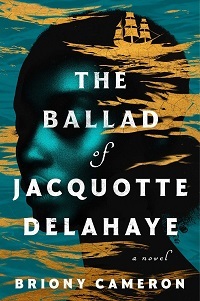 Briony Cameron's debut novel is based on the legend of Jacquotte Delahaye, a biracial woman of color from Saint-Domingue who reportedly became a pirate captain in the 17th-century Caribbean. Atria, June 2024.
Briony Cameron's debut novel is based on the legend of Jacquotte Delahaye, a biracial woman of color from Saint-Domingue who reportedly became a pirate captain in the 17th-century Caribbean. Atria, June 2024.
 Immerse yourself in the political and cultural world of the Indian Ocean in the 12th century, full of bustling international trade and dangerous threats, in Chakraborty's historical fantasy novel. First in a series, it sees the title character—a widow, mother, and former pirate—tempted into one more adventure at sea. Harper Voyager, February 2023.
Immerse yourself in the political and cultural world of the Indian Ocean in the 12th century, full of bustling international trade and dangerous threats, in Chakraborty's historical fantasy novel. First in a series, it sees the title character—a widow, mother, and former pirate—tempted into one more adventure at sea. Harper Voyager, February 2023.
 The South China Sea in the 19th century is the setting for this debut about a pirate queen of legend, Shek Yeung, and the risks she takes to solidify power in a patriarchal world. Bloomsbury, May 2023.
The South China Sea in the 19th century is the setting for this debut about a pirate queen of legend, Shek Yeung, and the risks she takes to solidify power in a patriarchal world. Bloomsbury, May 2023.
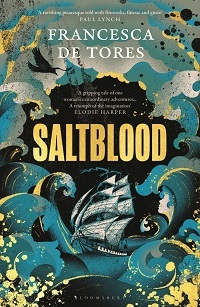 De Tores (who also writes as Francesca Haig) dives into the life story of Mary Read, who recounts her adventurous life, from her childhood, when she was raised as a boy, through her later years as a notorious pirate. Bloomsbury UK, April 2024.
De Tores (who also writes as Francesca Haig) dives into the life story of Mary Read, who recounts her adventurous life, from her childhood, when she was raised as a boy, through her later years as a notorious pirate. Bloomsbury UK, April 2024.
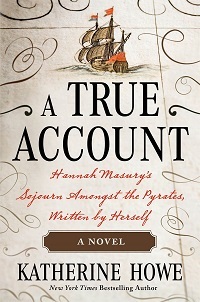 Howe (The Physick Book of Deliverance Dane) writes an exciting tale about Hannah Masury, an indentured servant who flees 18th-century Boston and dons a disguise as a cabin boy about a pirate ship. In a parallel timeline, a 1930s-era researcher uncovers Hannah's story. Henry Holt, November 2023.
Howe (The Physick Book of Deliverance Dane) writes an exciting tale about Hannah Masury, an indentured servant who flees 18th-century Boston and dons a disguise as a cabin boy about a pirate ship. In a parallel timeline, a 1930s-era researcher uncovers Hannah's story. Henry Holt, November 2023.
 Part three in her Joubert Family Chronicles, Mosse's The Ghost Ship tells a story about a vessel of secrets, romance, and piracy that moves from Europe to the Barbary Coast in the 1620s. Minotaur, July 2023.
Part three in her Joubert Family Chronicles, Mosse's The Ghost Ship tells a story about a vessel of secrets, romance, and piracy that moves from Europe to the Barbary Coast in the 1620s. Minotaur, July 2023.
 The swashbuckling tale of Anne (Coleman) Bonny, a young woman from Ireland's County Cork who immigrates to America in the early 18th century with her family and turns to a life of the sea on a quest for freedom and adventure. New Island Books, April 2024.
The swashbuckling tale of Anne (Coleman) Bonny, a young woman from Ireland's County Cork who immigrates to America in the early 18th century with her family and turns to a life of the sea on a quest for freedom and adventure. New Island Books, April 2024.
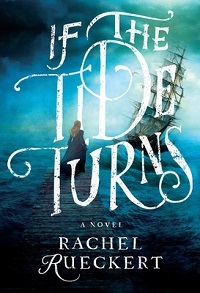 Based on the legend of pirate Samuel Bellamy, Rueckert's debut is an adventurous star-crossed love story about Sam, an orphaned sailor from Cape Cod, and the woman he loves, Maria Brown, whose affluent family refuses to entertain Sam as a suitor for her. Kensington, March 2024.
Based on the legend of pirate Samuel Bellamy, Rueckert's debut is an adventurous star-crossed love story about Sam, an orphaned sailor from Cape Cod, and the woman he loves, Maria Brown, whose affluent family refuses to entertain Sam as a suitor for her. Kensington, March 2024.
 Briony Cameron's debut novel is based on the legend of Jacquotte Delahaye, a biracial woman of color from Saint-Domingue who reportedly became a pirate captain in the 17th-century Caribbean. Atria, June 2024.
Briony Cameron's debut novel is based on the legend of Jacquotte Delahaye, a biracial woman of color from Saint-Domingue who reportedly became a pirate captain in the 17th-century Caribbean. Atria, June 2024. Immerse yourself in the political and cultural world of the Indian Ocean in the 12th century, full of bustling international trade and dangerous threats, in Chakraborty's historical fantasy novel. First in a series, it sees the title character—a widow, mother, and former pirate—tempted into one more adventure at sea. Harper Voyager, February 2023.
Immerse yourself in the political and cultural world of the Indian Ocean in the 12th century, full of bustling international trade and dangerous threats, in Chakraborty's historical fantasy novel. First in a series, it sees the title character—a widow, mother, and former pirate—tempted into one more adventure at sea. Harper Voyager, February 2023. The South China Sea in the 19th century is the setting for this debut about a pirate queen of legend, Shek Yeung, and the risks she takes to solidify power in a patriarchal world. Bloomsbury, May 2023.
The South China Sea in the 19th century is the setting for this debut about a pirate queen of legend, Shek Yeung, and the risks she takes to solidify power in a patriarchal world. Bloomsbury, May 2023. De Tores (who also writes as Francesca Haig) dives into the life story of Mary Read, who recounts her adventurous life, from her childhood, when she was raised as a boy, through her later years as a notorious pirate. Bloomsbury UK, April 2024.
De Tores (who also writes as Francesca Haig) dives into the life story of Mary Read, who recounts her adventurous life, from her childhood, when she was raised as a boy, through her later years as a notorious pirate. Bloomsbury UK, April 2024. Howe (The Physick Book of Deliverance Dane) writes an exciting tale about Hannah Masury, an indentured servant who flees 18th-century Boston and dons a disguise as a cabin boy about a pirate ship. In a parallel timeline, a 1930s-era researcher uncovers Hannah's story. Henry Holt, November 2023.
Howe (The Physick Book of Deliverance Dane) writes an exciting tale about Hannah Masury, an indentured servant who flees 18th-century Boston and dons a disguise as a cabin boy about a pirate ship. In a parallel timeline, a 1930s-era researcher uncovers Hannah's story. Henry Holt, November 2023. Part three in her Joubert Family Chronicles, Mosse's The Ghost Ship tells a story about a vessel of secrets, romance, and piracy that moves from Europe to the Barbary Coast in the 1620s. Minotaur, July 2023.
Part three in her Joubert Family Chronicles, Mosse's The Ghost Ship tells a story about a vessel of secrets, romance, and piracy that moves from Europe to the Barbary Coast in the 1620s. Minotaur, July 2023. The swashbuckling tale of Anne (Coleman) Bonny, a young woman from Ireland's County Cork who immigrates to America in the early 18th century with her family and turns to a life of the sea on a quest for freedom and adventure. New Island Books, April 2024.
The swashbuckling tale of Anne (Coleman) Bonny, a young woman from Ireland's County Cork who immigrates to America in the early 18th century with her family and turns to a life of the sea on a quest for freedom and adventure. New Island Books, April 2024. Based on the legend of pirate Samuel Bellamy, Rueckert's debut is an adventurous star-crossed love story about Sam, an orphaned sailor from Cape Cod, and the woman he loves, Maria Brown, whose affluent family refuses to entertain Sam as a suitor for her. Kensington, March 2024.
Based on the legend of pirate Samuel Bellamy, Rueckert's debut is an adventurous star-crossed love story about Sam, an orphaned sailor from Cape Cod, and the woman he loves, Maria Brown, whose affluent family refuses to entertain Sam as a suitor for her. Kensington, March 2024.
Published on May 25, 2024 05:00



